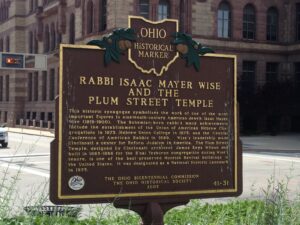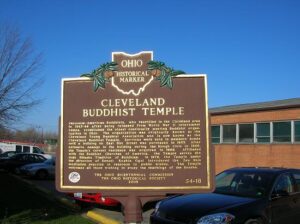, OH
The figure atop the Soldiers’ Monument has looked over Youngstown’s Central Square since 1870. Ohio Governor David Tod began campaigning for a monument for Youngstown’s fallen soldiers even before the Civil War ended. The community raised $15,000, and the cornerstone was laid in 1868. The memorial was completed and dedicated on July 4, 1870, with Governor Rutherford B. Hayes and Congressman James A. Garfield, both future U.S. presidents, attending the ceremony. Four cannons procured by Garfield formerly surrounded the monument. In 1951 the figure on the pedestal was accidentally damaged. A new statue of Carrara marble was commissioned, sculpted in Italy, and installed in 1955. The Bertolini Bros., a local marble firm, donated the new figure, which as patterned after the original, as their gift to the city.
, OH
This historic synagogue symbolizes the work of one of the most important figures in nineteenth-century American Jewry, Isaac Mayer Wise (1819-1900). The Bohemian-born rabbi’s many achievements include the establishment of the Union of American Hebrew Congregations in 1873, Hebrew Union College in 1875, and the Central Conference of American Rabbis in 1889. Wise’s leadership made Cincinnati a center for Reform Judaism in America. The Plum Street Temple, designed by Cincinnati architect James Keys Wilson and built in 1865-1866 for the B’nai Yeshurun congregation during Wise’s tenure, is one of the best-preserved Moorish Revival buildings in the United States. It was designated as a National Historic Landmark in 1975.
, OH
The Hindu Temple of Toledo was established in 1981 for the growing Hindu and Jain communities in northwest Ohio. Religious functions were initially held in a house located on a 15-acre property purchased in 1983. The Temple, designed in a Hindu-American style, was dedicated in August 1989. In 2000, the Temple underwent an expansion of 6000 square feet to the Heritage Hall area. Deities, Ganesh, Krishna, Radha, Vishnu, Laxmi, Rama, Sita, and Mahavir, are housed in the Temple. The holy structure is a living legacy of peaceful co-existence among religions and cultures.
, OH
Japanese-American Buddhists, who resettled in the Cleveland area in 1943-44 after being released from World War II internment camps, established the oldest continually meeting Buddhist organization in Ohio. The organization was originally known as the Cleveland Young Buddhist Association and is now known as the Cleveland Buddhist Temple. Services were held in members’ homes until a building on East 81st Street was purchased in 1955. After extensive damage to the building during the Hough riots in 1966, the Temple’s current residence was acquired in 1968. Affiliated with the Buddhist Churches of America, the Temple serves the Jodo Shinshu Tradition of Buddhism. In 1979, the Temple under the direction of Sensei Koshin Ogui introduced the Zen Shin meditation practice in response to public wishes. The Temple welcomes all those wishing to study the teachings of the Buddha.
, OH
In 1968, the International Society for Krishna Consciousness (ISKCON) established the first practicing Vedic Temple in the state of Ohio. This building represents the beginning of a now growing population of Vaisnavas, worshipers of Vishnu or Krishna, in Ohio who have integrated into the mainstream daily life here without forsaking their own unique traditions. Daily worship ceremonies, formally installed deities, marriage ceremonies, final rites, and many other significant ceremonies related to Vedic culture are practiced at the temple. These ceremonies are prevailed over by authorized Pujaris or priests. The ISKCON House upholds and represents those values sacred to Vedic culture: peacefulness, tolerance, equanimity, patience, truthfulness, honesty, austerity, and mercy. In this sacred place, there is no breaking of the regulative principles of Dharma (religion): no meat eating, no intoxication, no gambling, and no illicit sex (outside marriage).
, OH
“Lifting As We Climb”: The Cincinnati Federation of Colored Women’s Clubs (CFCWC) was organized May 6, 1904, during a meeting called by Mary Fletcher Ross at the Allen Temple A.M.E. Church. Gathering together eight existing African-American women’s clubs, the CFCWC sought to unite in their work promoting “the betterment of the community.” At a time when both government and private philanthropies overlooked the needs of Black Americans, CFCWC members helped to organize the city’s first kindergartens for Black children, taught in Cincinnati African-American public schools –including the Walnut Hills Douglass and Stowe schools—and raised money for the Home of Aged Colored Women. Since 1904, the Cincinnati Federation of Colored Women’s Clubs has ensured the civic and constitutional rights of all African Americans while meeting the needs of their city.
, OH
Here in 1963 congregants of Beth Israel-The West Temple, led by Louis Rosenblum, Herb Caron, and Rabbi Daniel Litt, founded the Cleveland Committee (later Council) on Soviet Anti-Semitism, the first American organization created to advocate for freedom for Soviet Jews. In 1970 this work led to the formation of the Union of Councils for Soviet Jews (UCSJ) under the leadership of Louis Rosenblum. The UCSJ, whose national office was located here 1970-1973, became the largest independent Soviet Jewry organization in the world. By the turn of the 21st century, the efforts begun here helped 1.6 million Jews leave the former Soviet Union. (Continued on other side)








